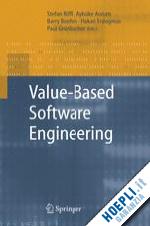
Questo prodotto usufruisce delle SPEDIZIONI GRATIS
selezionando l'opzione Corriere Veloce in fase di ordine.
Pagabile anche con Carta della cultura giovani e del merito, 18App Bonus Cultura e Carta del Docente
Dr. Stefan Biffl is an associate professor of software engineering at the Institute of Software Technology and Interactive Systems, Vienna University of Technology. He received his MS and PhD in computer science from the Vienna University of Technology and his MS in social and economic sciences from the University of Vienna. He is founder of the Quality Software Engineering research group (QSE) at the Vienna University of Technology. His research interests include project and quality management in software engineering, software inspection, decision support for software engineering processes, and collaboration among project stakeholders. He is a member of the ACM and IEEE.
Dr. Aybüke Aurum is a senior lecturer at the School of Information Systems, Technology and Management, University of New South Wales. She received her BSc and MSc in geological engineering, and MEngSc and PhD in computer science. She is the founder and group leader of the Requirements Engineering Research Group (ReqEng) at the University of New South Wales. She also works as a visiting researcher in National ICT, Australia (NICTA). She is chief editor of "Managing Software Engineering Knowledge" published by Springer in 2003. Her research interests include Management of Software Development Process, Software Inspection, Requirements Engineering, Decision Making and Knowledge Management.
Dr. Paul Grünbacher Associate Professor at Johannes Kepler University Linz and a research associate at the Center for Software Engineering (University of Southern California, Los Angeles). He studied Business Informatics and holds a Ph.D. from the University of Linz. Paul’s research focuses on applying collaborative methods and tools to support and automate complex software and system engineering activities such as requirements elicitation and negotiation or software inspections. He is a member of ACM, ACM SIGSOFT, and IEEE. He is General Chair of ASE 2004, the 19th IEEE International Conference on Automated Software Engineering.
Barry Boehm is known for four main contributions to software engineering. He was the first to identify software as the primary expense of future computer systems, he developed COCOMO, the spiral model, and pedegogy. Boehm worked at RAND, TRW, Inc, DARPA, and is currently TRW Professor of Software Engineering, Computer Science Department, and Director, USC Center for Software Engineering. Recent awards include the Office of the Secretary of Defense Award for Excellence (1992), the ASQC Lifetime Achievement Award (1994), and the ACM Distinguished Research Award in Software Engineering (1997). He is an AIAA Fellow, an ACM Fellow, an IEEE Fellow, and a member of the National Academy of Engineering.











Il sito utilizza cookie ed altri strumenti di tracciamento che raccolgono informazioni dal dispositivo dell’utente. Oltre ai cookie tecnici ed analitici aggregati, strettamente necessari per il funzionamento di questo sito web, previo consenso dell’utente possono essere installati cookie di profilazione e marketing e cookie dei social media. Cliccando su “Accetto tutti i cookie” saranno attivate tutte le categorie di cookie. Per accettare solo deterninate categorie di cookie, cliccare invece su “Impostazioni cookie”. Chiudendo il banner o continuando a navigare saranno installati solo cookie tecnici. Per maggiori dettagli, consultare la Cookie Policy.